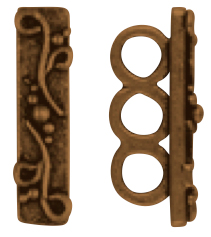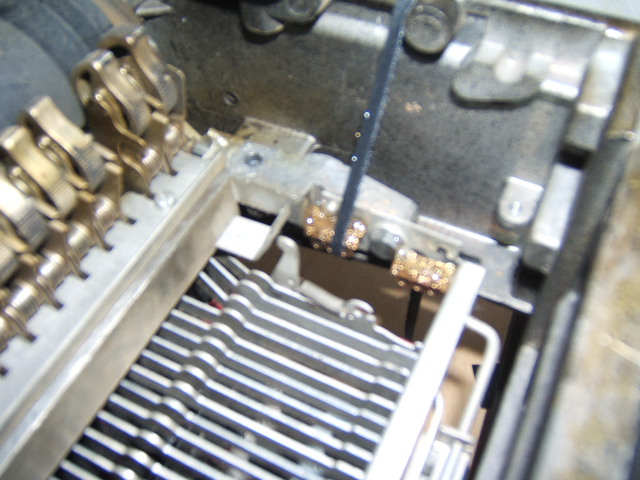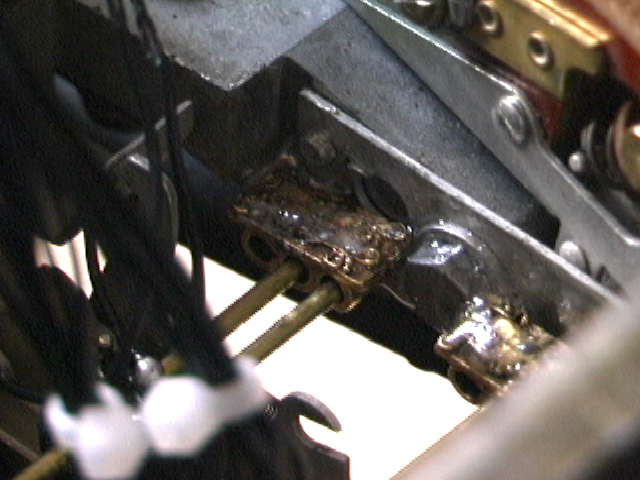Typewriter Computer Keyboard

A typewriter that's a computer keyboard? Or a computer keyboard that's a typewriter?
The world may never know.
Regardless, using one of these brings with it a certain giddiness not normally found in typing one's own name. Not to mention, it's ever so popular with the ladies, house guests and lady house guests.
Downloads
Go Get Stuff.


Parts:
1 - Model A IBM Electric Typewriter (EBAY!)
1 - Cheap USB keyboard
50 - Mini momentary push buttons
8 - Multi-strand spacer bars (metalliferous.com - Part #QB7853Y)
4 - 12" round brass rods (metalliferous.com - Probably, if memory holds true, Part #BR6075)
2 - Prototype circuit board (PCB)
1 - 5 minute epoxy
1 - Spool of 22AWG black wire
1 - Role black gaffer's tape
1 - Role white gaffer's tape
50 - Small plastic zip ties
Tools:
- Soldering iron
- Cutting pliers
- Small hacksaw
- Needle-nose pliers
- Screwdrivers
(Note that some of the links on this page are affiliate links. This does not change the cost of the item for you. I reinvest whatever proceeds I receive into making new projects. If you would like any suggestions for alternative suppliers, please let me know.)
Remove the Power Switch.


The first thing you are going to want to do is flip the typewriter upside down and remove and/or break some of the parts.
There should be a switch which is connected to both the power supply and the key-lock bar. This switch needs to be detached completely and removed by clipping the wire. Also, now would be a good time to cut off the power plug.
Pop Out the Metal Bars.



The other redundant metal bar can be easily pried out. Do that.
Now locate the metal bar that locks the keys in place. Remove the spring wrapped around the middle of this bar. You can try pulling it off with your pliers. If that does not work, try snipping it with your clippers. If both of those methods are giving you trouble, you can always saw it in half. Once the bar no longer has the spring action, removing it should be a tad bit easier.
The next thing that needs to be done is to saw off the little round tab that helps keep the bar pivoting along its path. This is a small steel bar and hard to remove short of sawing it off. If you are looking at your keyboard with the key-side closest to you, it should be on the right.
Once the small metal guide bar is removed, the next step is to forcibly remove the key-stop. Simply, close your eyes and pry it out with a screwdriver. You are closing your eyes on the slim chance it pops out and hits you in the face.
Prepare the Bracket System.

Once these 4 multi-strand spacers are cut, put them in pairs of two. Line up the holes and go get your epoxy. Glue them together on their ornate side (i.e. the side you didn't cut) so that they are glued together side by side with the holes still lined up. Be sure not to get epoxy in the holes.
Do the same thing with the 4 multi-strand spacers you didn't cut. Make groups of two and glue them together in the same manner.
Trim the brass bars so that they can precisely fit across the legnth of the inside part of the typewriter (the section above the keys).
Arrange the Switches on the Bars.



But first, it would be helpful to understand how the typewriter is going to work. When a typewriter key is pressed down, the long bar the key is attached to will strike a button which will then interface with a keyboard circuit and send that letter into the computer.
Therefore it is important that the bar is able to strike the button.
From my research, I have found that with the switches I am using, no more than 6 can be placed side by side. Once a seventh is added, it will start being missed by the striker bar.
To combat this, I have set up a system where I have created two staggered rows of switches that alternate groupings of 6 (see diagram).
Start putting the switches on the bars. Wrap the groups of six tightly together with thin strips of black gaffer's tape. Remember that some keys (such as "Return") may be on their own and not in a grouping.
Glue the Brackets Into the Typewriter.


Essentially the brackets are glued to the inside of the case, upside down (because don't forget the typewriter is still upside down). There should be one glued to each side of that big bolt (see picture).
Now here is the tricky part. The brackets need to be glued in a manner so that when the typewriter is flipped back right-side-up, the buttons will be as close to the striker bars as possible without being pushed down.
Again, this may seem easy enough, but remember that the weight of the buttons will make the bars sag towards the middle, which means when you glue in the brackets you should overcompensate with the placement a tiny bit on each side. If you don't overcompensate, the keys in the buttons in the middle won't be hit by the striking bar.
But wait! If you overcompensate too much, the buttons on the end may get pushed down without being hit. Again a major problem.
So, in short, be very careful placing the brackets just right.
Which brings me to the next big reason this step is so annoying: the epoxy takes about 20 hours to fully set. Thus, the length of this project is dependent on how many tries this step takes. Every time you have to redo this step, the project will take one day longer to complete. Still, don't be disheartened if you wait an entire day for it to dry only to learn that you have to break out your chisel and glue it again.
With that said, you also have to figure out a way to firmly hold the brackets in place for the 20 or so hours for the epoxy to reach full strength. This can be tricky in and out of itself. I used a thin piece of tape wrapped tightly all the way around the side of the case.
Hack the Keyboard.

Make sure to map out all typewriter keys that you intend to use.
Prepare the PCB Registers.


So, for instance, if "Pin 3" on "Side A" has 9 alphanumeric symbols associated with it, then the PCB that represents "Side A" should have 9 connected wires of about 12" running off of it.
And to these 9 wires (electrically connected on the PCB) you would then connect the wire from your hacked keyboard that represents "Pin 3" of "Side A".
Essentially, all of these 9 wires would need to be connected to "Pin 3."
So..... when you're done, each board should have one wire running off of it for every typewriter key you plan on using.
They should be a mess of wires, as seen in my picture.
Another thing to consider is that some PCBs have holes in them to connect them to stands. I connected mine to a small acrylic stand. I did this so that none of the soldered connections accidentally get bridged if they come into contact with metal on the typewriter (see secondary picture).
Connect the Keyboard to the PCB Registers.


Connect the PCB Wires to the Switches.



Make certain that you are soldering to the terminals that make a connection when the switch is pushed and not the terminals that are connected when the switch is not.
With that said, to one of the terminals solder the wire that routes to the corrsponding pin on "Side A" and to the other terminal solder the wire that routes to the corresponding pin on "Side B."
Do this slowly and carefully with every switch.
Troubleshoot Until There Is No Tomorrow.


No matter if you've done everything right up until now, chances are you will probably have something go wrong.
If absolutely nothing happens, your keyboard is probably dead. Make certain of this and then go hack another one.
If one key is being typed into the window over and over and over, then one of the buttons is being pressed down by the striker bar. See if it stops when you slide the button out from under that key's striker bar. If it stops, all that means is that you have to reposition your bracket so that the key isn't being pushed down. Pry it lose and break off the epoxy. Reposition and re-glue the bracket.
If it does not stop hitting the key over and over, start to cry. There is something very wrong with your wiring and/or many keys are being repeatedly struck at once and confusing the keyboard. Determine which it is and then act accordingly.
If nothing happens until you press a key down, then you are doing well. See if you can get every key you press to show up on the screen. This may take some repeated calibration.
Glue Everything in Place.



Once all the keys are calibrated, slowly and carefully flip the computer back over. Glue the brass bars into the brackets with hot glue and the groups of switches in place on the brass bar with hot glue as well.
Wait a few minutes for it to dry and then flip it back over.
Plug it in and test to see that all of the keys still work. If they do, good. If not, break off the glue and reposition the afflicted keys once more so that they do. Repeat this until it works solidly.
Flip the typewriter upside down one last time and using your twist ties organize the wires into groupings as best you can for the sake of neatness. Only do this part if you care about neatness.
Do As the Ancients.

Now is the time to pound away at those keys. This can get to be kind of brutal on the wrist after a while. Although, it is kind of fun to pretend to be Ernest Hemingway (even though I doubt he ever used one of these International Business Monsters).
One last thing... If you find you are sometimes hitting a key and the letter is showing up twice, slow down the speed that the computer is checking for new keystrokes. That should do the trick.

Did you find this useful, fun, or entertaining?
Follow @madeineuphoria to see my latest projects.